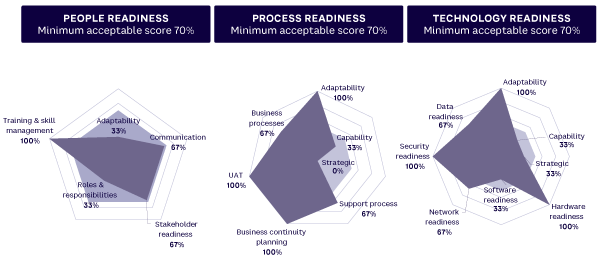This three-part Advisor series explores a challenge that present-day organizations often confront: effectively navigating digital transformations within an evolving ecosystem. A frequent approach involves establishing a dedicated change management team to spearhead the human aspect of digital transition. However, this strategy encounters complexities due to the uncertain objectives and variable scope and duration of transformation projects. Leaders and steering committees (SteerCos) face a pivotal decision: should they sustain a sizable change management team, develop program-specific change capabilities, or disband the team post-project?
Here in Part I, we lay out the challenges associated with change in digital transformations and explore an innovative solution to those challenges that leverages data analytics and generative AI (GenAI).
Challenges Associated with Digital Change
In the current business and technology landscape, where disruption outpaces Moore’s law, organizations face myriad challenges in digital transformation initiatives, including:
-
Organizational resistance. One of the primary challenges that organizations face during transformation is resistance to change. Employees often fear that new technologies will render their current skills obsolete, leading to reduced morale and productivity. A common refrain among clients is the struggle to achieve desired return on investment (ROI) from transformations, often citing poor management in adopting change. It is essential for the CMO to proactively address these concerns through robust communication and engagement strategies.
-
Change fatigue in long-term initiatives. Organizations that embark on large, multiyear transformation programs are prone to change fatigue. This is especially common when dealing with cutting-edge technologies, which often require continuous upskilling and adaptation from employees. A CMO can alleviate this fatigue by pacing change initiatives in manageable phases and ensuring that stakeholders have access to the necessary resources and training.
-
Skills and resource gaps. Large-scale transformation efforts also highlight gaps in skills and resources, particularly in organizations that lack experience with GenAI-driven solutions. Acquiring the right-skilled resources is often a significant hurdle, requiring strategic partnerships and global resourcing efforts.
Innovative Solution: GenAI- & Data-Driven CMO
We believe in a reimagined role for the CMO as a strategic “orchestrator” in the “symphony” of digital transformation. The CMO should guide and strategically align various teams, leveraging data analytics and GenAI insights for end-to-end visibility and synchronization. This centralized unit will consolidate change management efforts to enhance change strategies, methodologies, and change-solution deployment.
The CMO will serve as a resource hub for change tools and templates and establish the value and credibility of change management in a digital-first world. The CMO, thus, becomes instrumental in identifying and seizing change management opportunities, making organizations more adaptable, efficient, and ready for the future.
Strategic Framework for Establishing a CMO
The creation of a CMO is a multifaceted process:
-
As a first step, it is essential to establish the organizational necessity for such an office. This involves an evaluation of the current change management landscape. Using an assessment framework, organizations can discern their readiness for change (see Figure 1). This assessment spans critical areas such as personnel, processes, and technology, offering insights into existing capabilities and areas of improvement. A scoring mechanism, possibly ranging from 20% to 100%, helps in quantifying this readiness, with a benchmark, perhaps at 70%, indicating a prepared state for effective change management.
-
Upon recognizing the need for a CMO, the next step is defining its vision and operational boundaries. Success hinges on the composition of the team, necessitating the selection of individuals with the right blend of skills, expertise, and experience in change management.
-
The governance framework of the CMO is the next critical component. It involves delineating the roles and responsibilities of the leadership and operational teams, establishing clear communication channels, and formulating decision-making protocols. This structure is the backbone that supports the operational activities of the CMO, including the development of change management methodologies, tools, procedures, and metrics.
-
Equally important is the development of a robust communication and engagement strategy. This strategy should cater to the diverse needs of all stakeholders within the organization, ranging from executive leadership to frontline employees, ensuring that everyone is aligned and committed to the change initiatives.
-
Lastly, the ongoing evaluation of the CMO’s effectiveness is vital. This involves tracking the progress of transformation initiatives, scrutinizing the efficacy of implemented change strategies, and adapting operations based on continual feedback and evolving organizational needs.

Case Study: Initial “Fit-Gap” Analysis
In a real-world scenario, we encountered an oil and gas organization poised to undertake numerous transformation initiatives. Their strategy was to methodically test concepts, learn from past breakdowns, and swiftly scale successful practices. This approach was designed to minimize damage, gain valuable insights, and foster a change culture. The organization performed a readiness assessment. This assessment, unlike traditional surveys, leveraged algorithms to deeply analyze various aspects such as personnel adaptability, process efficiency, technological integration, and organization culture.
The insights garnered from this assessment were instrumental in developing a suite of customized solutions, tailored to bridge the identified gaps. The SteerCo was able to make informed decisions, selecting the most suitable solution that aligned with the company’s technological context, financial constraints, and time frame. It enabled the organization to anticipate potential challenges and dynamically adjust its strategies.
Part II of this Advisor series continues this conversation and provides a CMO solution catalog.




